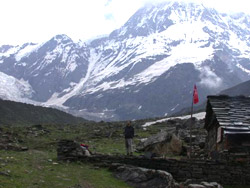 The Pindari Glacier is one of the most easily accessible glaciers of all the Himalayan glaciers. While passing through the most dramatic scenery in the Himalayas, one reaches under the shadow of the snow-covered giants. As one reaches to the upper levels, the trees start shrinking, the pines cease and the track enters an enchanted garden of leaf, wild flowers and rhododendron. The Pindari Glacier is extends to 3.2 km length and 1.5km width, which is enclosed by mighty mountain ranges. It stretches upto 3,656 to 4,265meters above the sea level on an open and undulating piece of ground. The Pindari Glacier is wedged between the Nanda Devi and Nanda Kot Peaks and terminates at an altitude of 3,627meters. It is one of the most breathtaking and enchanting spot for those who are nature enthusiasts and lovers of flawless glory. The appearance of Pindari Glacier is very white and at some places, spots of light blue and brown colour may also come into notice. Trekking in Pindari Glacier is a surpassing and an exciting unforgettable experience.
The Pindari Glacier is one of the most easily accessible glaciers of all the Himalayan glaciers. While passing through the most dramatic scenery in the Himalayas, one reaches under the shadow of the snow-covered giants. As one reaches to the upper levels, the trees start shrinking, the pines cease and the track enters an enchanted garden of leaf, wild flowers and rhododendron. The Pindari Glacier is extends to 3.2 km length and 1.5km width, which is enclosed by mighty mountain ranges. It stretches upto 3,656 to 4,265meters above the sea level on an open and undulating piece of ground. The Pindari Glacier is wedged between the Nanda Devi and Nanda Kot Peaks and terminates at an altitude of 3,627meters. It is one of the most breathtaking and enchanting spot for those who are nature enthusiasts and lovers of flawless glory. The appearance of Pindari Glacier is very white and at some places, spots of light blue and brown colour may also come into notice. Trekking in Pindari Glacier is a surpassing and an exciting unforgettable experience.
Geographical Location
The Pindari glacier lies in the Bageshwar district of the Kumaon Himalayas. It is located in the Pinder Valley between logitudes 79° 13`-80°02` E and latitudes 30* 15` N. It occupies an area of 339.39sq.kms. Pinder River flows through this valley, overlooking from the Pindari glacier.
Accessibility
By Air
The nearest airport is Pant Nagar at a distance of 206 km.
By Railways
The nearest railway station is Kathgodam located at a distance of 180kms.
By Road
Bageshwar is well connected with all the major towns of the state. Local transport services like jeeps and buses are available at large and frequent.
Distances
Distances from major towns of the state
Bageshwar 36 kms
Almora 109 kms
Kathgodam199 kms
Pindari glacier 45 kms



















